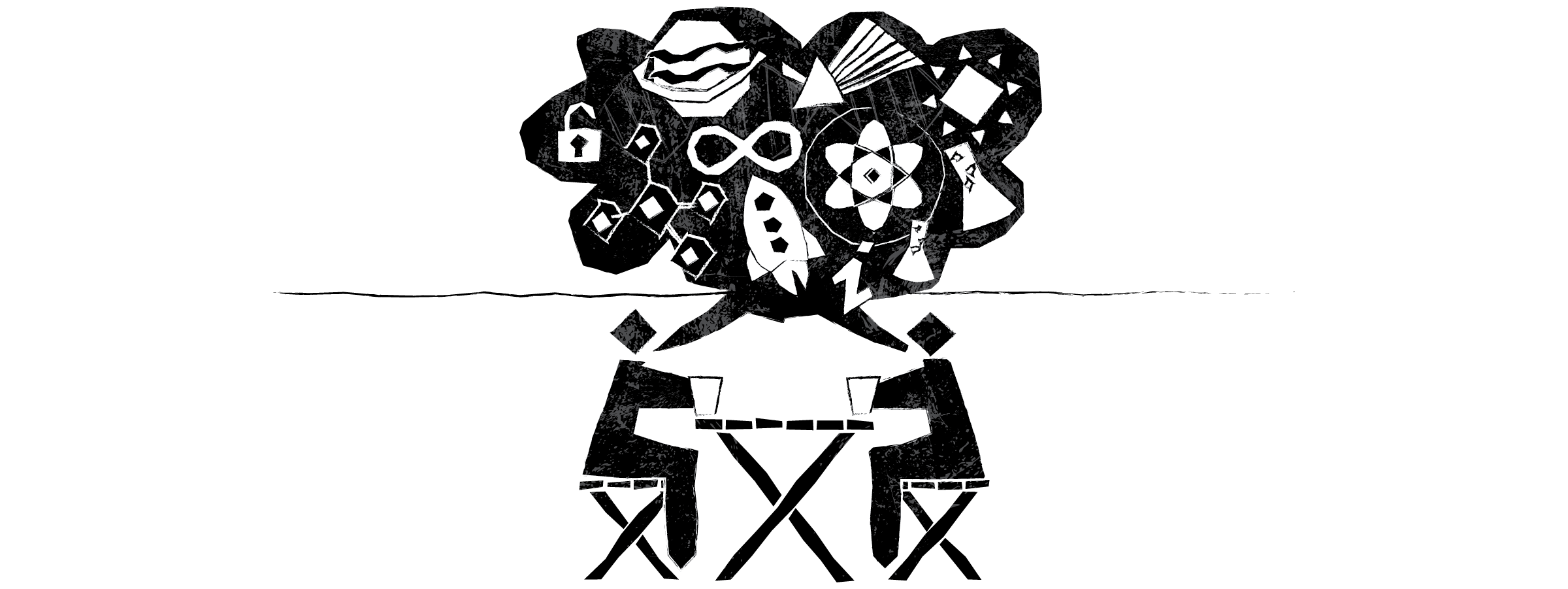Finding friendships and social connections in college can seem daunting, I know. Depending on what school you plan to attend, there might be tens of thousands of other students on campus, rushing from class to class. You might be sitting in classes with hundreds of other students. How does one start making friends in such an overwhelming crowd? It’s easy to become painfully isolated, especially if you live off-campus or don’t get along with others in your residence. Indeed, difficulties with social interaction are the most common challenge reported in research on autistic college students (Anderson, Stephenson, & Carter, 2017).
But before we tackle the challenge of social isolation at college, I hope you’ll forgive me if we take some time to consider the background to the problem. In a fascinating article, Elizabeth Fein (2015) suggests that our modern world has, in some ways, made it more difficult for autistic people to connect with others. Humans used to live in smaller communities, and in a sense, you were stuck with the people around you. People might not always get along, but they had to live with one another. However, in the modern world, many of us live in enormous cities. If we don’t enjoy spending time with others, we can just find new friends. Those of us on the autistic spectrum might be less comfortable friends for most neurotypical people, so we can get left behind in this more competitive environment.
Grade school is, in a sense, a bit like the way the world used to be. You’re sort of stuck with people. To put it mildly, you won’t always get along with others – I’ve been bullied, and many autistics will have been similarly victimized – but it’s perhaps easier to avoid becoming completely isolated.
College is different. When there are thousands of students, who can freely choose to hang out with whomever they please, it’s easy for us autistics to get completely left out. At college, in a way, there’s a sort of competition for friendship, and those of us with worse social skills are at a disadvantage in that competition.
Now, you might think that working on your social skills is the solution to this problem. If friendship is all really just a sort of competition, then you might think that the best way to find friends is to fit in better, to beat the competition in the game of being the most typical. But that’s not my point here – quite the contrary, in fact!

The flip side of the freedom to choose friends is that it’s possible for those of us who might be a little on the quirky side – whether or not we have a formal autism diagnosis – to hang out with one another. In a qualitative study on the friendships of autistic adults, researchers found that the most successful friendships were not based on the autistic adults successfully meeting the expectations of neurotypical society, but instead, on common interests and on the acceptance of atypical behavior (Sosnowy et al., 2018). Autistic participants in the study said that their genuine relationships weren’t about trying to fit in, but about being accepted for themselves.
Indeed, not only can it be stressful and unrewarding to maintain the pretence of being someone you are not, but you might still be unable to succeed as well as a neurotypical student. Studies by Sasson and colleagues (2017) found that neurotypical people can instantly form negative judgements of autistic people based only on subtle differences in how we move and express ourselves in short video clips and even in still images. There are genuine limits to the degree to which most of us can successfully pretend to be normal.
Of course, this still leaves us with a big challenge: how do we find people who would share common interests with us, who would enjoy spending time with us, and who would accept us for who we are?
Well, that’s where clubs come in! Colleges will generally have numerous student-run clubs. Clubs are very popular with autistic students – one study suggests that joining a club is the most common non-academic support used by autistic students (Anderson, Carter, & Stephenson, 2017), and that’s for good reason. Based on my experience and the experiences of other autistic students, my best recommendation for any autistic student seeking friendships is to find information about clubs, identify some clubs that look interesting, and try attending one of their meetings. If you feel a sense of connection with the other club members, you could join that club. If you don’t feel that connection, you could try another club.
There are a number of ways you can find information about clubs. There’s usually an online directory maintained by the college or by the student society. This directory should list all of the clubs on campus and it should have some way you could contact the club organizers. If the directory provides the organizers’ email address, but not meeting dates and times, you could just send a short email saying that you are a student interested in joining the club and asking if they could please send you any relevant information, including the date and time of their next meeting.
Furthermore, around the beginning of the fall semester (and perhaps at the beginning of the winter/spring semester as well), your college will probably hold some kind of forum where representatives of clubs can sit at tables and offer information to prospective members. If the event is held indoors, it might be too noisy, but if you don’t mind the noise or if the event is held outside, you could attend. The advantages of this approach are that you would get to meet one or two people from the club, which might give you a better sense of whether the club is a good fit for you, and also that you might feel more comfortable at the club meeting if you already know someone from the club.
My personal experience with college clubs starts even before I was accepted to the school where I did my undergraduate studies. Because I knew about a peer-support group for autistic students on that campus, I asked the club’s facilitator – another autistic student – if I could attend before being formally admitted, and he let me in. I later joined a larger disability group as well. Many if not most of the social connections I formed on campus came from these two groups. Personally, I think there’s something incredibly special about communities of autistic and neurodivergent people: we’re not all alike, but we all know what it’s like to be different, which makes us more accepting of people for who they are.
Of course, that’s not to say that friendships based on shared interests can’t be incredibly rewarding as well. There are even empirical studies – albeit in a grade school setting – that show how successful clubs based on interests can be (Koegel et al., 2012, 2013). I’ve always had intense interests, at least since elementary school, and it’s rewarding to be able to talk about them with people who really care.
And of course, please feel free to join this conversation and add any comments you may have about this post! Have you ever joined a club – and if so, how did it work? Is there something you think I’ve forgotten or overlooked? Let us know your thoughts.
Some Additional Notes You Might Find Helpful:
Many clubs are purely recreational, with members having some common interest, but others might be professional clubs for students in a particular field or discipline. The first type of clubs are more likely to be free, while the professional clubs are perhaps more likely to have membership dues. Some clubs may allow members to drop by meetings when they have time and interest, while others might demand a larger time commitment. It’s probably a good idea to check about costs and time commitments when you are considering joining a club.
Clubs usually have high turnover, because some students are always graduating, and others are arriving. Thus, even if you didn’t connect with the members of a club in the past, it might be worth checking in again after a year or two, in case the club’s membership has changed.
If you are anxious about attending a club meeting, you could ask a friend or support person to come with you. College students are usually busy, but you could also try asking one of the organizers if you could meet them before the club meeting. (It is, of course, perfectly normal to be nervous before entering an unfamiliar environment. Back when I was still in grade school, I made the organizers of a theatre group come to my house, and meet me in that safe setting, before I would commit to joining their group!)
The Organization for Autism Research (2018) produces a guide to college for autistic students. On page 63, there’s a handy checklist of things to remember when you are organizing yourself to go to a club meeting.
References
Anderson, A. H., Carter, M., & Stephenson, J. (2017). Perspectives of university students with autism spectrum disorder. Journal of Autism and Developmental Disorders. Advance online publication. https://doi.org/10.1007/s10803-017-3257-3
Anderson, A. H., Stephenson, J., & Carter, M. (2017). A systematic literature review of the experiences and supports of students with autism spectrum disorder in post-secondary education. Research in Autism Spectrum Disorders, 39, 33–53. https://doi.org/10.1016/j.rasd.2017.04.002
Fein, E. (2015). “No one has to be your friend”: Asperger’s syndrome and the vicious cycle of social disorder in late modern identity markets. Ethos, 43(1), 82–107. https://doi.org/10.1111/etho.12073
Koegel, R., Fredeen, R., Kim, S., Danial, J., Rubinstein, D., & Koegel, L. (2012). Using perseverative interests to improve interactions between adolescents with autism and their typical peers in school settings. Journal of Positive Behavior Interventions, 14(3), 133–141. https://doi.org/10.1177/1098300712437043
Koegel, R., Kim, S., Koegel, L., & Schwartzman, B. (2013). Improving socialization for high school students with ASD by using their preferred interests. Journal of Autism & Developmental Disorders, 43(9), 2121–2134. https://doi.org/10.1007/s10803-013-1765-3
Organization for Autism Research. (2018). Finding your way: A college guide for students on the spectrum. Arlington, VA: Organization for Autism Research. Retrieved from https://researchautism.org/findingyourway/
Sasson, N. J., Faso, D. J., Nugent, J., Lovell, S., Kennedy, D. P., & Grossman, R. B. (2017). Neurotypical peers are less willing to interact with those with autism based on thin slice judgments. Scientific Reports, 7, 40700. https://doi.org/10.1038/srep40700
Sosnowy, C., Silverman, C., Shattuck, P., & Garfield, T. (2018). Setbacks and successes: How young adults on the autism spectrum seek friendship. Autism in Adulthood, 1(1), 1–8. https://doi.org/10.1089/aut.2018.0009





1 Comment